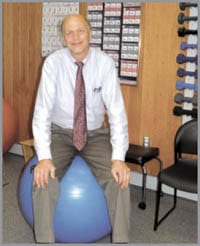Body of Evidence Most Sports-related Neck and Back Injuries Are Preventable
Dr. Julio Martinez-Silvestrini calls them “the terrible toos.”
“People do too much, too fast, too soon,” said the sports medicine physician from Baystate Rehabilitation Care in East Longmeadow, as he talked about how and why sports-related injuries to the spine occur.
“If people followed simple rules, they could avoid most injures. But getting in shape takes time, and people are impatient. As soon as the snow melts every year, golfers go out and play 18 holes without stretching. And someone who has never run before will decide to run a marathon, put their sneakers on, and run two miles the first day,” he said, adding that such individuals usually end up getting hurt.
Dr. Charles Mick agrees. “If you want to lift weights, don’t try to lift 250 pounds the first day,” said the orthopedic surgeon from Pioneer Spine and Sports Physicians in Northampton. “Athletes want to maximize their ability, but they need to do it gradually with common-sense training.”
But many people make the wrong choices. In addition, some sports injuries cannot be avoided. As a result, physicians see adolescents and adults who have injured their neck and/or back playing sports. Their conditions range from muscle strains and sprains to ruptured discs and, in rare cases, spinal-cord damage, which can result in paralysis or even death.
The injuries occur from participation in a wide variety of activities, which include golf, running, football, baseball, BMX biking, martial arts, cheerleading, lacrosse, diving, horseback riding, car racing, surfing, and more.
“Most of the time, back injuries are not related to an acute event,” Martinez-Silvestrini said. “They result from overuse and repetitive movements using bad body mechanics.”
Anatomy Lesson
Martinez-Silvestrini says the back can be divided into three parts: the cervical or neck region, the mid-thoracic spine, and the lower or lumbar spine.
In general, muscle strains are the most common type of injury. “At some point, almost every athlete strains a muscle,” Mick said. “Sore backs are common, and aches and pains are part of getting stronger.”
However, Dr. Christopher Comey of New England Neurosurgical Associates in Springfield says it’s not unusual to see patients with injuries that range from nerve irritation to cervical spinal fractures.
“Lumbar or lower back strain usually responds to pain medication, restriction of activity, and anti-inflammatory medication. Longer-lasting injuries can involve pinched nerves, which can happen when a disc is herniated and a piece of it lodges against the nerve. The pain can start out in the back and, several days later, travel down the leg. But only 10{06cf2b9696b159f874511d23dbc893eb1ac83014175ed30550cfff22781411e5} of patients with these conditions require surgery,” he said. “The majority respond to physical therapy, rest, and, on occasion, cortisone injections.”
The most common injury to the neck is whiplash. “It can happen in any sport where the person is moving at high velocity; if a football player is tackled in the chest, his neck continues to move forward, which stretches all of the ligaments and muscles that support the cervical spine,” Martinez-Silvestrini said. “Once you get to the point of maximum deformity, there is a recoil mechanism, and the neck goes backward.
“Sometimes, it overcorrects and bounces back and forth,” he continued. “The opposite happens when someone is tackled from the back. Their neck snaps backward, which stretches all of the front neck muscles because the head is moving at a different velocity than the trunk of the body.”
In most cases, whiplash results in nothing more than a stiff neck, which improves with rest. “The way to differentiate between a mild sprain versus a more serious one is pain that doesn’t improve with rest, or tingling or numbness,” said Martinez-Silvestrini. “In more severe cases, there may be weakness, walking difficulty, or problems with bowel or bladder control.”
A common football and wrestling injury is called a ‘stinger’ or ‘burner’ because it causes sudden pain and/or numbness and tingling that lasts for a few seconds and feels similar to hitting the ‘funny bone.’ It results from overstretching the brachial plexus network of nerve fibers that run from the neck to the arm.
Mick says stingers can be frightening, but are usually not dangerous. However, in rare instances there can be permanent nerve damage, and symptoms should not be ignored if the athlete has another episode during play.
Injuries to the thoracic vertebrae in the back are typically mild, since the rib cage provides protection and stability. However, if and when they do occur, they can result in damage to the spinal cord.
But lower back pain is the complaint that sends most people to their doctor. And although many people ignore it, Comey said chronic low back pain in young athletes should be taken seriously.
“There is a tendency to think, ‘it’s a kid, so what could possibly be wrong?’ But I have seen children who have developed stress fractures in the lower spine,” Comey told HCN. “If they’re recognized early, they can usually be treated with non-surgical means, including external bone stimulators that encourage bone growth.”
However, if a stress fracture in a young person goes untreated, they can develop slippage of the spine, or spondylolthesis, which typically occurs when the L5 bone slips out of the proper position and slides forward on the first bone in the pelvis or sacrum, which causes back and leg pain.
Braces are sometimes used to treat stress fractures in young athletes, and they may be able to return to playing sports after the fracture heals, Comey said.
But in many cases, the fracture never heals, and although the pain subsides, it can reoccur if the person returns to play. “I’ve had several UMass varsity football players who were unable to play again,” Mick said.
Prevention Matters
Correct posture, proper equipment, maintaining flexibility, and overall conditioning can go a long way toward reducing neck and back injuries, experts say.
“People need to be fit to play a sport, rather than playing sports to be fit,” Martinez-Silvestrini said. “Three major elements that are important are flexibility, strength, and good aerobic capacity.”
Mick agrees. “A sports program needs to be balanced,” he said. “Sometimes football players will only do strength training and not work on balance, which is very important. And when people think about baseball, they think about the shoulder. But if someone wants to throw a pitch at 90 mph, they need to use their leg, trunk and back muscles. So if they just exercise their shoulder and arm muscles, they may injure their back when they are throwing fastballs.”
Golf is another sport where posture is critical. “When someone wants to pick up a golf ball, they should bend down or use a golfer’s reach,” Martinez-Silvestrini said. He demonstrated the move by leaning forward while keeping his back straight and reaching out with one hand while extending the opposite leg.
Comey says golf is not bad for the spine, but people with low back problems need to warm up and do some stretching before they begin to play. He recommends people visit www.spineuniverse.com to learn helpful exercises.
Physical therapy can be useful after an injury, and sessions with an athletic trainer or coach can make a difference after initial healing takes place. “A trainer can create a program that focuses on strength, endurance, balance, and coordination,” Mick said.
However, some people are unable to return to the sport that led to their injury, especially if their lower back pain is caused by degenerative changes.
“Distance running can be very difficult on the lower back due to the constant pounding transmitted to the spine with each step,” Comey explained. “Pain can come from discs which no longer function as shock absorbers. They literally wear out, which is no different than wearing out a hip or knee.”
Worthwhile Pastime
The bottom line is that most spinal sports injuries are mild and don’t cause permanent damage. “If pain goes away within a day or two and is fairly mild, there is no need to get excited,” Mick said. “But it does need to be evaluated if it is severe, keeps coming back, or doesn’t go away.”
Comey agrees and says 90{06cf2b9696b159f874511d23dbc893eb1ac83014175ed30550cfff22781411e5} of people develop debilitating back pain at some point in their life.
But the risk of hurting one’s back or neck is not a reason to avoid sports, Mick said. “The benefits of regular exercise and participation in sports far outweigh the risk of injury.”



Comments are closed.